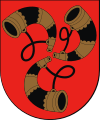Piaski
Piaski (Polish pronunciation: [ˈpjaskʲi]), formerly Piaski Luterskie, is a town in Poland at the Giełczew river. The town's population is about 2,660 (2004). Administratively it belongs to Powiat of Świdnik of the Lublin Voivodeship. It lies 16 km Southeast of Świdnik.
Piaski | |
|---|---|
 Main thoroughfare in Piaski | |
 Coat of arms | |
 Piaski | |
| Coordinates: 51°8′3″N 22°50′41″E | |
| Country | |
| Voivodeship | Lublin |
| County | Świdnik |
| Gmina | Piaski |
| Government | |
| • Mayor | Ryszard Siczek |
| Area | |
| • Total | 8.43 km2 (3.25 sq mi) |
| Population (2006) | |
| • Total | 2,626 |
| • Density | 310/km2 (810/sq mi) |
| Time zone | UTC+1 (CET) |
| • Summer (DST) | UTC+2 (CEST) |
| Postal code | 21-050 |
| Car plates | LSW |
| Website | www.piaski.pl |
History
The first mention of the village located near the site of the current town and called Pogorzały Staw comes from the 1401 document. The first specific mention of Piaski occurs in the Latin chronicle of Jan Długosz from 1470 which calls the town "Pyassek alias Gyelczew" (alias here meaning formerly), where Giełczew is the name of another local village. Based on this evidence, it is thought that the town of Piaski came into existence some time in the first half of the 15th century on the lands formerly belonging to those two villages. In the 16th and 17th centuries a significant part of the town's population was Protestant, hence it became known as Piaski Luterskie (Lutheran).
Eventually, the town's Jewish community grew to eventually constitute two thirds of the total inhabitants. In 1795 during the Third Partition of Poland, the town became part of Habsburg Austria. In 1809 it briefly passed to the Duchy of Warsaw, before becoming part of Congress Poland under Russian rule from 1815 onward. In 1869 Piaski lost its municipal rights as punishment for the January Uprising. After World War I, since 1918 it has belonged to reconstituted sovereign Poland. In 1921, Piaski had 2,674 Jews among its 3,974 inhabitants.
The Holocaust
During the German occupation of Poland, in the course of World War II, the town of Piaski became part of the semi-colonial General Government. At the beginning of this period, 4,165 Jews resided in Piaski. In 1940 the Nazi German occupiers established the Piaski ghetto, to imprison not only its Jewish inhabitants, but also several thousand Jews transported from the Lublin Ghetto as well as from the German Reich and Czech Republic.[1] In 1942, the ghetto was liquidated with the use of Reserve Police Battalion 101 from Hamburg. Its inmates, loaded onto Holocaust trains, perished in the nearby Bełżec extermination camp in three separate transports. The Jewish community ceased to exist.[2]
Facilities
In 1993 Piaski recovered its municipal rights, officially becoming a town again after a break of over a hundred years. Near Piaski there is a TV transmission site, with a 342-metre-high (1,122 ft) guyed mast, one of the tallest in Poland.
Notable people
- Andrzej Zaorski (born 1942), actor and cabaret artist
- Antoni Norbert Patek de Prawdzic (born 1812), watchmaker, co-founder of Patek Philippe
Notes
- https://collections.ushmm.org/search/catalog/irn507303
- Browning 1998, pp. 51–53.
References
- Browning, Christopher R. (2001). "Arrival in Poland". Ordinary Men: Reserve Police Battalion 101 and the Final Solution in Poland (PDF). United Kingdom: Penguin Books. p. 49. ISBN 9780141000428. OCLC 838611906. Archived from the original (PDF file, direct download 7.91 MB) on 2013-10-19.
- "Official webpage: Town History" (in Polish). Urząd Miejski w Piaskach. 27 February 2013.
- "The Piaski Ghetto. Town history". Survivors, Rabbis of Piaski, Righteous Gentiles. Remember Jewish Piaski - Genealogy Group. 2014. Retrieved 24 July 2014. With selection of period photographs, list of references and relevant weblinks.
- Dane Głównego Urzędu Statystycznego: Ludność. Stan i struktura w przekroju terytorialnym. Stan w dniu 31 XII 2008 r.